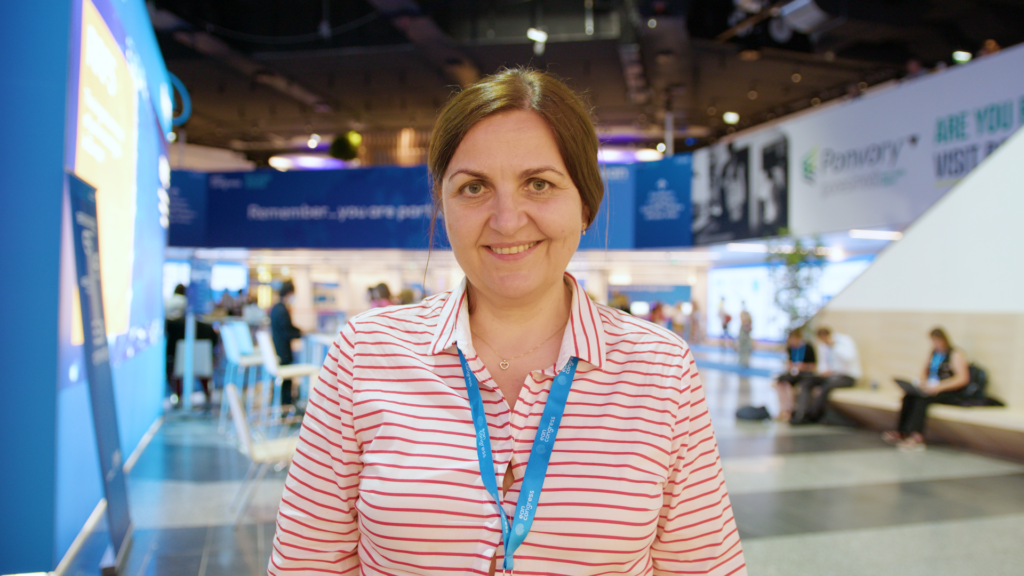The 70th Annual American Academy of Neurology (AAN) Meeting was held on April 21–27, 2018, in Los Angeles. This is one of the most important events in the neurology community, industry representatives presented plenty of new data on current and emerging disease-modifying therapies (DMTs) for multiple sclerosis (MS).
Genentech’s presentations showcased their targeted B-cell therapy ocrelizumab. In an open-label extension of the OPERA I and II studies, switching from interferon (IFN) beta-1a to ocrelizumab at the start of an open-label extension period led to rapid and sustained reductions in magnetic resonance imaging (MRI) based disease activity (T1 and T2 gadolinium-enhancing lesions). Patients initially randomised to ocrelizumab had lower whole brain, white matter and cortical grey matter tissue loss after 4 years of continuous treatment compared with those switched to ocrelizumab 2 years later. In addition, data from the phase III Ocrelizumab Biomarker Outcome Evaluation (OBOE) study added to the growing body of evidence supporting the use of biomarkers of disease activity and therapeutic response in MS, which was a hot topic at this year’s meeting. Treatment with ocrelizumab reduced the levels of nerve damage and inflammation biomarkers in cerebrospinal fluid, including the median concentration of neurofilament light chain (NfL; a reduction of 24% at week 12 and 47% at week 24) and the median number of CD19+ B cells (a reduction of 86% at week 12 and 82% at week 24).1 Finally, at 12 and 24 weeks, ocrelizumab significantly lowered the risk of cognitive decline in patients with relapsing MS (RMS) as assessed by the Symbol Digit Modalities Test (SDMT).2
Novel, oral, selective sphingosine 1-phosphate 1 and 5 (S1P1 and S1P5) receptor modulators are among the most promising new drugs to emerge in recent years. Despite suffering a recent setback when the US Food and Drug Administration (FDA) refused to file its application for ozanimod because of insufficient information, Celgene presented positive findings on the drug from recent analyses of the SUNBEAM and RADIANCE clinical trial data. These showed a reduction in annualised relapse rates (ARR) in a number of pre-specified subgroups: disability severity at baseline (Expanded Disability Status Scale [EDSS] score ≤3.5 versus EDSS > 3.5), presence of gadolinium-enhanced lesions at baseline and prior treatment with disease-modifying drugs (DMTs). According to Ludwig Kappos, Chair of the Department of Neurology at the University of Basel and presenter of one of the abstracts, these data “provide robust evidence that supports ozanimod as a potential new therapeutic option in a broad spectrum of patients with relapsing multiple sclerosis”.3
Presentations from Novartis featured their S1P1 and S1P5 receptor modulator, siponimod. In a pre-specified analysis of the phase III EXPAND study in patients with secondary progressive multiple sclerosis (SPMS), siponimod reduced the risk of confirmed disability progression in relapsing and non-relapsing patients.4 Siponimod also showed beneficial effects on cognitive processing speed, the major cognitive function affected by MS.5 In addition, in an analysis of blood NfL levels in EXPAND participants, the patients who took siponimod for more than 21 months had a 5.7% reduction in NfL levels, whereas those in the placebo group had a 9.2% increase.6 This increase in blood NfL in the placebo group contrasts with observations in previous relapsing-remitting MS (RRMS) studies. The relevance of NfL serum levels in progressive disease therefore warrants further study.
EMD Serono/Merck presented new data on cladribine tablets (Mavenclad®) and IFN beta-1a (Rebif®). Data on cladribine tablets included post-hoc analyses of the CLARITY, CLARITY Extension and ORACLE-MS trials, as well as the impact on B- and T-cells. The IFN beta-1a studies included no evidence of disease activity (NEDA), long-term disease activity measured by the Magnetic Resonance Imaging in MS (MAGNIMS) score, pregnancy outcomes for women receiving IFN beta-1a treatment, and real-world evidence assessing adherence to treatment in patients treated with IFN beta-1a compared with dimethyl fumarate.7
New data from Sanofi Genzyme’s phase IV Teri-PRO study and phase III TENERE extension trial showed that patients with RMS who switched from IFN beta-1a therapy to teriflunomide (Aubagio®) experienced significant improvements in treatment satisfaction as measured by the Treatment Satisfaction Questionnaire for Medication (TSQM).8 With increased options for therapy switching, patient-reported outcomes are increasingly relevant. In addition, new data from the CARE I and CARE II studies showed that patients with RMS who received alemtuzumab (Lemtrada®) experienced beneficial effects on disease activity that were maintained over 7 years. The incidence of most adverse events during the extension was comparable or reduced compared with previous studies.9 Alemtuzumab also showed sustained improvements in a range of health-related quality of life measures over 6 years in treatment-naive patients with RRMS.10 However, the recent identification of rare, potential side effects of alemtuzumab reminds us of the need for ongoing post-marketing surveillance data.11
New treatment modalities in clinical development were also highlighted at the AAN meeting. MediciNova’s first-in-class, small-molecule phosphodiesterase- and macrophage migration inhibitory factor-inhibitor, ibudilast (MN-166), has already demonstrated a neuroprotective effect in RMS in a previous phase II study. Data from the SPRINT-MS phase IIb trial evaluating ibudilast in progressive MS, showed that ibudilast treatment reduced the rate of progression of whole brain atrophy by 48% compared with placebo.12 According to Yuichi Iwaki, President and Chief Executive Officer of MediciNova, “With a convenient oral administration, a very favourable safety and tolerability profile compared to other MS drugs, and potentially better efficacy than any other drug for progressive MS, we believe ibudilast is well positioned to become the best-in-disease drug.”13
Finally, in addition to real-world data demonstrating that people with RMS treated with dimethyl fumarate (Tecfidera®) or natalizumab (Tysabri®) early in the course of their disease experience better long-term outcomes;14 Biogen presented safety data from the first 3 months of the phase III EVOLVE-MS-1 study for BIIB098 (formerly known as ALKS 8700) an oral, monomethyl fumarate (MMF) prodrug. These interim data show that treatment with BIIB098 was associated with low rates of gastrointestinal adverse events leading to discontinuation (0.5%) and no occurrence of serious gastrointestinal adverse events.15
The rapidly expanding treatment landscape for MS has confounded choices for physicians, therefore the announcement of the first new guidelines on the use DMTs since 2002 was timely and welcome. The updated AAN guidelines feature 30 recommendations: 17 on starting DMTs, including recommendations on who should start them; 10 on switching DMTs if breakthrough disease develops; and three on stopping DMTs. The guidelines also recommend commencing treatment earlier rather than later in the disease course.16 However, a number of controversies remain unanswered in the guidelines, the most important of which is the decision as to which DMT should be used after diagnosis of relapsing MS. This illustrates the need for ongoing studies to inform what has become a complex decision-making process.
Interviews with MS experts:
References
1. Bar-Or A, Gelfand J, Fiore D, et al. Interim analysis of the OBOE (Ocrelizumab Biomarker Outcome Evaluation) study in multiple sclerosis (MS). Neurology. 2018;90(15 Suppl): S24.002.
2. Cohan S, Benedict R, De Seze J, et al. Time to cognitive worsening in patients with relapsing multiple sclerosis in ocrelizumab phase III trials. Neurology. 2018;90(15 Suppl): S44.005.
3. Celgene. New analyses from pivotal phase III trials of oral ozanimod in relapsing multiple sclerosis to be presented at the 2018 American Academy of Neurology Annual Meeting. Available at: http://ir.celgene.com/releasedetail.cfm?releaseid=1064723 (accessed 25 April 2018).
4. Cree B, Fox R, Giovannoni G, et al. Uncoupling the impact on relapses and disability progression: siponimod in relapsing and non-relapsing patients with secondary progressive multiple sclerosis in the phase III EXPAND study. Neurology. 2018;90(15 Suppl):S8.005.
5. Benedict R, Cree B, Tomic D, et al. Impact of siponimod on cognition in patients with secondary progressive multiple sclerosis: results from phase III EXPAND study. Oral presentation at the 70th Annual Meeting of the American Academy of Neurology, Los Angeles, CA, April 21–27, 2018.
6. Kuhle J, Kropshofer H, Barro C, et al. Siponimod reduces neurofilament light chain blood levels in secondary progressive multiple sclerosis patients. Neurology. 2018;90(15 Suppl): S8.006.
7. Merck. Merck highlights commitment to advance multiple sclerosis treatment with MAVENCLAD® and Rebif® data at AAN 2018. Available at: www.merckgroup.com/en/news/mavenclad-and-rebif-data-at-aan-13-04-2018.html (accessed 25 April 2018).
8. Vermersch P, Gold R, Meca-Lallana J, et al. Treatment satisfaction with teriflunomide in patients switching from a prior disease-modifying therapy: results from the phase 3 TENERE and phase 4 Teri-PRO clinical trials. Neurology. 2018;90(15 Suppl):P6.396.
9. Sanofi Genzyme. Treatment effects maintained over seven years in patients with relapsing remitting multiple sclerosis who received Lemtrada® (alemtuzumab) in clinical trials. Available at: www.businesswire.com/news/home/20180423005766/en/Treatment-Effects-Maintained-Years-Patients-Relapsing-Remitting (accessed 26 April 2018).
10. Arroyo R, Guo JD, Zhang W, et al. Alemtuzumab improves patient-reported quality of life outcomes in patients with relapsing-remitting multiple sclerosis: results from the CARE-MS I extension study. Neurology. 2018;90(15 Suppl):P6.380.
11. Muraro PA, Scolding NJ, Fox RJ. Rare side effects of alemtuzumab remind us of the need for postmarketing surveillance. Neurology. 2018; DOI 10.1212/WNL.0000000000005409 [Epub ahead of print].
12. Fox R, Ashokkumar A, Barnes J, et al. A phase II trial of ibudilast in progressive multiple sclerosis. Neurology. 2018;90(15 Suppl):CT.004.
13. MediciNova. MediciNova announces the presentation of the SPRINT-MS phase 2b trial of MN-166 (ibudilast) in progressive MS at the American Academy of Neurology (AAN) 70th Annual Meeting Plenary Session with additional imaging data. Available at: https://globenewswire.com/news-release/2018/04/24/1486033/0/en/MediciNova-Announces-the-Presentation-of-the-SPRINT-MS-Phase-2b-Trial-of-MN-166-ibudilast-in-Progressive-MS-at-the-American-Academy-of-Neurology-AAN-70th-Annual-Meeting-Plenary-Ses.html (accessed 26 April 2018).
14. Biogen. Biogen builds on its 40-year legacy in neuroscience with presentation of research from its portfolio of medicines and investigational programs for neurodegenerative diseases. Available at: www.businesswire.com/news/home/20180417005632/en/Biogen-Builds-40-Year-Legacy-Neuroscience-Presentation-Research (accessed 26 April 2018).
15. Naismith R, Leigh-Pemberton R, Rezendes D, et al. EVOLVE-MS-1: a phase 3, open-label, long-term safety study of ALKS 8700 in relapsing-remitting multiple sclerosis. Neurology. 2018;90(15 Suppl):P6.360.
16. Rae-Grant A, Day GS, Marrie RA, et al. Practice guideline recommendations summary: Disease-modifying therapies for adults with multiple sclerosis: Report of the Guideline Development, Dissemination, and Implementation Subcommittee of the American Academy of Neurology. Neurology. 2018; DOI 10.1212/WNL.0000000000005347 [Epub ahead of print].











